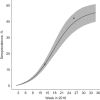Real-Time Assessment of Health-Care Requirements During the Zika Virus Epidemic in Martinique
- PMID: 28200111
- PMCID: PMC5860153
- DOI: 10.1093/aje/kwx008
Real-Time Assessment of Health-Care Requirements During the Zika Virus Epidemic in Martinique
Abstract
The spread of Zika virus in the Americas has been associated with a surge in Guillain-Barré syndrome (GBS) cases. Given the severity of GBS, territories affected by Zika virus need to plan health-care resources to manage GBS patients. To inform such planning in Martinique, we analyzed Zika virus surveillance and GBS data from Martinique in real time with a modeling framework that captured dynamics of the Zika virus epidemic, the risk of GBS in Zika virus-infected persons, and the clinical management of GBS cases. We compared our estimates with those from the 2013-2014 Zika virus epidemic in French Polynesia. We were able to predict just a few weeks into the epidemic that, due to lower transmission potential and lower probability of developing GBS following infection in Martinique, the total number of GBS cases in Martinique would be substantially lower than suggested by simple extrapolations from French Polynesia. We correctly predicted that 8 intensive-care beds and 7 ventilators would be sufficient to treat GBS cases. This study showcased the contribution of modeling to inform local health-care planning during an outbreak. Timely studies that estimate the proportion of infected persons that seek care are needed to improve the predictive power of such approaches.
Keywords: Guillain-Barré syndrome; Zika virus; epidemic forecasts; health-care planning.
© The Author(s) 2017. Published by Oxford University Press on behalf of the Johns Hopkins Bloomberg School of Public Health.
Figures





Similar articles
-
Guillain-Barré syndrome risk among individuals infected with Zika virus: a multi-country assessment.BMC Med. 2018 May 15;16(1):67. doi: 10.1186/s12916-018-1052-4. BMC Med. 2018. PMID: 29759069 Free PMC article.
-
Guillain-Barré Syndrome Associated With Zika Virus Infection in Martinique in 2016: A Prospective Study.Clin Infect Dis. 2017 Oct 16;65(9):1462-1468. doi: 10.1093/cid/cix588. Clin Infect Dis. 2017. PMID: 29020245
-
Guillain-Barré Syndrome outbreak associated with Zika virus infection in French Polynesia: a case-control study.Lancet. 2016 Apr 9;387(10027):1531-1539. doi: 10.1016/S0140-6736(16)00562-6. Epub 2016 Mar 2. Lancet. 2016. PMID: 26948433 Free PMC article.
-
Zika virus infection and Guillain-Barré syndrome: a review focused on clinical and electrophysiological subtypes.J Neurol Neurosurg Psychiatry. 2017 Mar;88(3):266-271. doi: 10.1136/jnnp-2016-314310. Epub 2016 Oct 31. J Neurol Neurosurg Psychiatry. 2017. PMID: 27799296 Review.
-
Incidence of Guillain-Barré Syndrome (GBS) in Latin America and the Caribbean before and during the 2015-2016 Zika virus epidemic: A systematic review and meta-analysis.PLoS Negl Trop Dis. 2019 Aug 26;13(8):e0007622. doi: 10.1371/journal.pntd.0007622. eCollection 2019 Aug. PLoS Negl Trop Dis. 2019. PMID: 31449532 Free PMC article.
Cited by
-
Dynamics of Zika virus outbreaks: an overview of mathematical modeling approaches.PeerJ. 2018 Mar 22;6:e4526. doi: 10.7717/peerj.4526. eCollection 2018. PeerJ. 2018. PMID: 29593941 Free PMC article.
-
Therapeutic Approaches for Zika Virus Infection of the Nervous System.Neurotherapeutics. 2017 Oct;14(4):1027-1048. doi: 10.1007/s13311-017-0575-2. Neurotherapeutics. 2017. PMID: 28952036 Free PMC article. Review.
-
A systematic review and evaluation of Zika virus forecasting and prediction research during a public health emergency of international concern.PLoS Negl Trop Dis. 2019 Oct 4;13(10):e0007451. doi: 10.1371/journal.pntd.0007451. eCollection 2019 Oct. PLoS Negl Trop Dis. 2019. PMID: 31584946 Free PMC article.
-
Quantifying Zika: Advancing the Epidemiology of Zika With Quantitative Models.J Infect Dis. 2017 Dec 16;216(suppl_10):S884-S890. doi: 10.1093/infdis/jix437. J Infect Dis. 2017. PMID: 29267915 Free PMC article. Review.
-
Comparative assessment of methods for short-term forecasts of COVID-19 hospital admissions in England at the local level.medRxiv [Preprint]. 2022 Jan 19:2021.10.18.21265046. doi: 10.1101/2021.10.18.21265046. medRxiv. 2022. Update in: BMC Med. 2022 Feb 21;20(1):86. doi: 10.1186/s12916-022-02271-x. PMID: 34704097 Free PMC article. Updated. Preprint.
References
-
- World Health Organization Zika situation report http://www.who.int/emergencies/zika-virus/situation-report/8-september-2... Published September8, 2016. Accessed September8, 2016.
-
- Centers for Disease Control and Prevention All countries and territories with active Zika virus transmission http://www.cdc.gov/zika/geo/active-countries.html Updated December16, 2016. Accessed December14, 2016.
-
- Musso D, Nilles EJ, Cao-Lormeau VM. Rapid spread of emerging Zika virus in the Pacific area. Clin Microbiol Infect. 2014;20(10):O595–O596. - PubMed
MeSH terms
Grants and funding
LinkOut - more resources
Full Text Sources
Other Literature Sources
Medical

